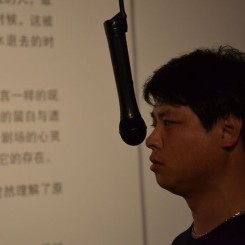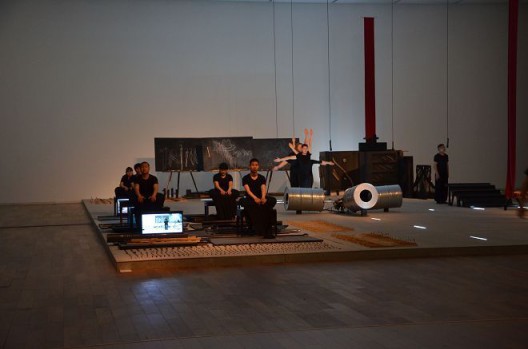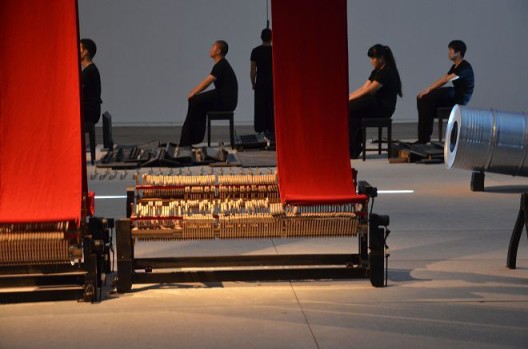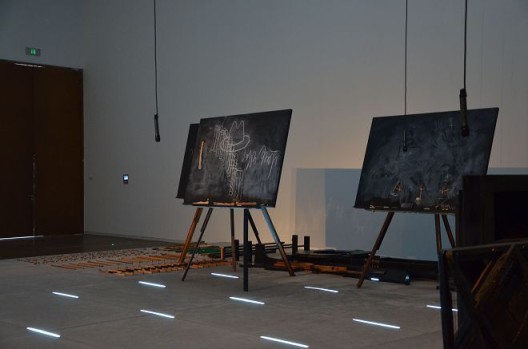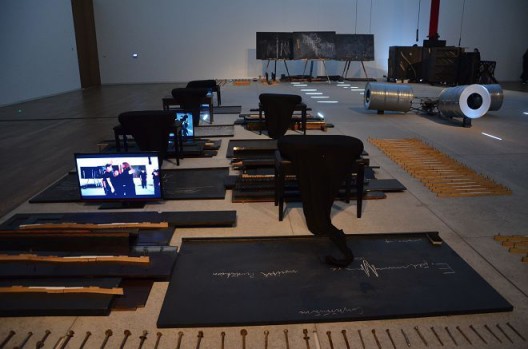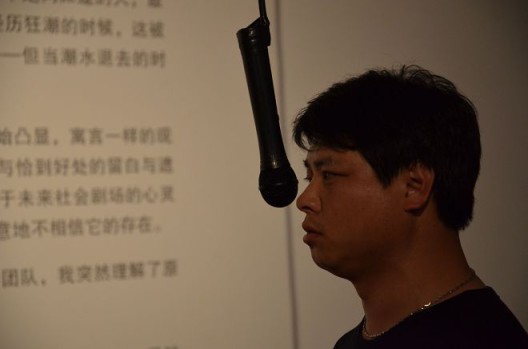Tianjin Art Museum (60 Pingjiang Dao, Hexi District 300201 Tianjin, China), Apr 26—May 20, 2015
Following his show in Wuhan, the “City of Rivers,” Yuan Gong arrived in Tianjin, “The Base of Nine Rivers.” This exhibition can be viewed in two ways; the first would be to observe it with a degree of scrupulousness, passing one’s eyes over each and every minute detail, taking a careful inventory of relevant information. The show is divided into two parts: a live performance and a multi-panel image installation. The opening performance portion, entitled “Scherzo,” was allegedly adapted from an extract from German playwright Heiner Müller’s, Die Hamletmaschine. Most of the performers are blind; lined up around the gallery space, one after another they come to the microphone and proclaim “I am Hamlet.” On a makeshift stage at the center of the space, several blackboards stand erect in homage to Joseph Beuys’ “Four Blackboards”. Metal barrel “cannons” let out rings of smoke at fixed intervals, and a pile of dismantled piano parts lies beside an array of screws, nuts and bolts. Nearby, strips of red cloth were suspended from the ceiling, connected at the bottom to clattering wooden contraptions on the floor. (Pictures of the site would undoubtedly provide a more clear-cut visual.) Another work called “Chanted Ode” is composed of several huge projection screens. Most of the images are the facial expressions of the blind performers. Next to each screen is written one word such as “we” or “freedom” and so on.
But such micromanaged observation may not be the easiest way to actually understand this exhibition or build meaning out of it. At least, the majority of audience members would likely respond with looks of utter bewilderment—unsurprising, given that in the absence of over-interpretation, it is very difficult to find any relationship between any two elements in this show: Hamlet and a piano? Nuts, bolts and blackboards?
Rather than adopting a further, simplified point of view, maybe it is best to be content with the “superficial” understanding our elemental observation engenders. Perhaps only in this way will we see it all more clearly: whether it is the live performance or the content projected onto these screens, here we have a set of symbols included among which are “theatre,” “marginalized populations” (the blind), “tradition” (gun powder, weaving machines)… The straightforward vocabulary of the projection screens also proves a strong attempt at meaningfulness with terms like “freedom,” “infinity,” “time and space,” “truth,” “immortality,” “turmoil”—words that betray a desirous clinging to ideology. Of course, we also see here references to both literature and classic cases of modern art: some experimental theater here, a pile of destroyed piano parts there (reminiscent of the destructive spirit of Dada or of Nam June Paik’s vandalism), a reproduction of Beuys’ blackboards. The forms Yuan Gong’s works take entail a similar abundance of choice; there are installations, performances, projections and even found objects. Yuan Gong’s “The Scented Air: Much More Than 6000m3” at the 2013 Venice Biennale showed a video recording of an airborne vehicle puffing out smoke, also accompanied by a “freedom” word list on loop, guiding the viewer’s train of thought and imagination in one calculated direction. All of this abundance serves to express one thing: that this is indeed one complete, comprehensive, and stylish array of “contemporary art.”

